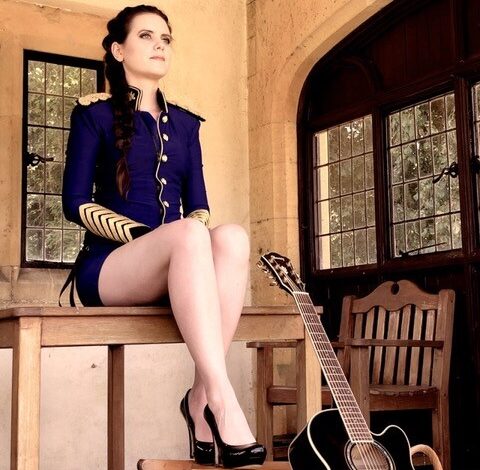Berit Hagen, aka the Commander-In-Chief of 7-String

As seen in Guitar Girl Magazine Issue 17 – Fall 2021
The Bells & Whistles
“I went to see a surgeon, and he told me, ‘either you can quit (guitar), or you need to start building strength,’ and I’m thinking, I’ve been playing for so many years. I have to build strength because I can’t give this up. That would be really sad.”
NOTE: This article originally appeared on our Fall 2021 edition which can be seen at the link above.
Strength prevailed for the self-taught guitar virtuoso, who goes by the moniker Commander-In-Chief. She survived a parasitic infection and shoulder injury. How? With lots of support and focusing on her mental and physical health. The year of the pandemic was a banner one for Hagen. While some were lamenting lockdown, the 7-string guitarist dove into her online business as if it were one “long launch and recording session.”
Clearly excited about life—her’s has gone from one extreme to the other: metal solos to classical sonnets and piano. The word toccata aptly mirrors Hagen. In classical music, it means: an instrumental work designed to display the technical prowess and proficiency of a performer. Emphasis on the technical, but decked out in stylish military outfits, the Commander-In-Chief is a full-on brand of maestro music. She once marched a heavy metal beat, but her spirit gravitated towards sweeter symphonic sounds. On landmark 2 Guitars: The Classical Crossover Album, Hagen soared over classical-meets-metal pieces. Later, her ambitious duo albums Berit, Vol. 1 and Berit, Vol. 2, stunningly weaved acoustic pieces, showcased guitar mastery and operatic vocals on classically-tinged contemporary.
As 2021 unfolds, the Commander-In-Chief has a classical state of mind. Her latest recording, The Virtuoso, is a bath of beautiful music with delightfully fierce guitar playing. “Hungarian Dance No. 5” sways, note-for-note like never before, as well as more favorites a la the Chief. An operatic-trained singer, she’s also working on a professional vocal course. But her inner metal still appears once in a while like the recent Viking-inspired voyage in harmonics “Nordic Barbarian”—an admittedly fun nod to her Nordic heritage.
“Music is music: I have a very open mind about it. And I think that gives you a healthy relationship with it—when you can appreciate all of its various templates, genres, and interpretations,” says Hagen while digital-detoxing in Italy. She made time to discuss lifestyle, music, as well as the topic of mental wellness, particularly among musicians.
You’ve found a middle ground between classical, metal, and singer-songwriter. Do you have a musical balance?
Oh, wow! Thank you. Yeah, I do. It’s quite nice to do different genres. When I first started out, I felt that I would only be doing heavy metal because I was a really die-hard metalhead. I thought that would just be a pretty straight thing and the only thing I would be doing. I think around 2013, that’s when, all of a sudden, I started venturing off into different sections, and it was a bit surprising to me, but actually, I’m very happy with where it has taken me.
How did you get into metal?
I’ve always been a music fan, but once I started playing the electric guitar, then the technical aspect really appealed to me. I started playing heavier, but I wasn’t satisfied. I felt like there were so many people talking about Metallica, and I wanted to see if there was something else out there. That’s when I got into extreme metal and discovered this whole universe because I started reading metal magazines. But I was coming more from the perspective of a guitar player and also a creative person. I felt I needed more influences. When I discovered extreme metal, like death metal and black metal, I thought, this is great, because now there’s more diversity with all the different types of metal bands. For me, this was a very interesting exploration.
For a while, you embraced a classical meets metal style, so there have been comparisons to Yngwie Malmsteen. How do you feel about that?
Yeah. I actually think it’s cool because it says to me that people are listening to the guitar thing and listening to the style because it’s classical, but I mean, his sound has more distorted guitars, and I have a cleaner tone. I’ve been collaborating; actually, I’ve done two collaborations so far with classical guitar (with Thomas Valeur; Craig Ogden). Then I collaborated with composer John Haywood—like movie soundtracks, clean guitar, and rewriting classical. I had been experimenting with classical music, but I think that Yngwie Malmsteen and myself have that in common—it’s classical but different variations, obviously. I think it’s a cool comparison. I wouldn’t mind, really.
Classical music has a cleaner tone.
Yeah, all the classical has a clean sound—all of it. I think that’s nice because it just makes it prettier, and you get more dynamics in there as well. At first, my plan was to actually use the tone I had when I played heavy metal music, but once I turned the distortion on, I didn’t feel like it was good for the piece that I was working on at the time. I wanted the piece to sound really nice and beautiful, essentially, because to me, that’s classical.

On The Virtuoso, once again, you have stellar collaborations; tell me more.
That’s the latest one that we did; it’s a recording with classical music: me playing classical on electric guitar. We added the three vocal tracks that were taken from the two acoustic albums, but it is mainly the guitar. I collaborated with John Haywood on two of the tracks; he’s worked a lot with David Garrett—a super violin composer. I worked with him on a couple of tracks where you have this combination of me playing with the clean guitar tone, and what he then brought to the table was his movie soundtrack-style because he’s a composer and arranger. We rewrote “Moonlight Sonata” and cut that tune together. That was quite nice and really cooI. I would like to make a full album with him. Then I also included the songs that I collaborated on with Craig Ogden, the classical guitar player. Then you have the three songs from the acoustic albums that are vocal-based to showcase the voice.
On Berit, Vol. 2, “The Manager” is a dynamic song on many levels. What effect are you using on that?
Actually, what I did on that song is I used PreSonus’ Ampire. I’m not using a real amp. I always use Studio One when I’m recording. That’s the DAW from PreSonus, their digital audio workstation, and I decided to check them out. I wanted something to go along with the song lyrics and change the guitar solo and make it cooler. Then I was thinking, ‘Okay, I need to make it sound a bit wacky.’ I wanted to use the tremolo bar, but you can’t really do that because you don’t get that type of sound (sings high). I was thinking, maybe I can get that effect by just using PreSonus’ Ampire inside Studio One. That was actually the old version, and now they updated it and made it even better. But I like it because I got the audio effect that I really wanted.
Have you used pedals at all in the past?
Yeah. When I was playing metal and doing solos, I always used an MXR Carbon Copy Analog Delay. However, for the last few years, I’ve been using whatever I get pre-installed in Studio One. I love this change for myself because I’m getting good with this revolution in technology. It’s more like PreSonus and Studio One and the guitar and myself. In terms of effects, I used the PreSonus studio on Berit, Vol 1. That was the old interface that they had, and they don’t make that anymore. I would have the direct input into Studio One and add reverb, beats, delay, analog delay, and pro-EQ, all of it digital. That was my sound for both albums: Berit, Vol. 1 and Berit, Vol. 2. That’s it. That was like my rig (laughs). That’s pretty much the style.
There are so many options in technology.
I’m actually very happy with how it has improved because when I was in high school, I remember my very first recording interface was a PreSonus product, funny enough, but it came with a recording program, and I remember using digital amps in there, and those digital amps were horrible—the digital amp world was really not amazing then, but it has improved tremendously.
Have you been surprised by something while recording?
I am surprised all the time because I listen for input and try and listen to what other people are saying. Sometimes it can be kind of brutal, but then I go, ‘Hmm?’ And I’ll try it out. It’s always a bit of an experiment because, like with “The Manager,” that was actually how the song came to be. I was working on this song, and Elizabeth, my manager, told me that she really didn’t like the lyrics, the structure, and it became obvious she didn’t like the song. In response to that, because we were working on the album and working every day for quite a while, I’m thinking, ‘Okay. So, you don’t like this. You don’t like that. You don’t like the key, the lyrics. So, you know what? I’m going to take the whole thing and rewrite it and call it “The Manager,” and I’m going to write about this process where I’m trying things, and you’re telling me that you don’t like them.’ It actually became a collaboration sort of a thing where you’re getting feedback as a creative artist, and then you’re responding, so it becomes a conversation, and that’s what the song is about.
Let’s talk guitars. Are you still playing an Ibanez 7-string?
Yeah, I’m currently using two Ibanez guitars, a 7-string acoustic AEL207E-TKS, and a 7-string electric S5527 Prestige—that’s the current (electric) Ibanez I’m using, and I changed it back in 2014 because the 7-string I was playing gave me some problems. It was a bit too heavy, and the neck was a bit too thick. I needed something lighter, faster, and easier for me to play because back then, that was the year I did the big classical album; basically, I needed to have a tool to get the job done. So I’ve been playing that Ibanez guitar since then, and I love it. It’s a really good guitar with a beautiful tone.
Did Ibanez customize anything for you?
No, they wanted to actually create a customized guitar, but I had a deadline with the studio, and the recording was quite expensive. I was thinking about the hours and how much I could get into each space. I was like, ‘Please send me a really good guitar. It doesn’t have to be custom.’ I wasn’t interested in waiting for that because I had part of my program with exercising and practicing, so that was on my mind. I customized it a bit with new pickups because I have an EMG endorsement, so I set it up with EMG 57-7H and 66-7H pickups. That’s the only alteration.
Check out PreSonus Ampire HD Pack Demo—“Nordic Barbarian” from The Commander in Chief with her Ibanez 7-string and cool Neon DR Strings.
What song are you playing in PreSonus’ Ampire Demo?
I created the demo video for my song “Nordic Barbarian,” where I’m showcasing the latest Ampire program and the different digital amps that they have because you get a whole color of different tones. What you hear in there is a Mesa Boogie kind of amp, which is really beautiful, and I realized instantly that it is just as good as actually using a real amp. For me, that was quite eye-opening. And then you can hear me using a Vox-type amp in there, which is really beautiful, and I think it’s very nice. Very beautiful round, nice tone, nice clean tone.
During COVID, we realized musicians were really affected, not being able to play live. I saw you did an online video with some outstanding female players. How did you adapt during the pandemic?
Yeah, I did. Did you see that? That was so cool. What I did during COVID was finally, I was able to work full hours again and be productive like I used to be before I got sick. For me, 2020 was like, ‘Yes! Finally, I can be really productive,’ and then, boom, all of a sudden, COVID came out of nowhere. Because things had been so bad for me with my health and income and all those things, my focus was on my online business, which is putting out new releases and showing up for work, basically. Throughout that whole period with lockdowns in the UK, I was glued to my computer. I was working every day on finishing Berit, Vol. 2, practicing and working on the next thing, The Virtuoso.
It was actually like the whole thing was one big launch and one long recording session. For me, that was really important because I’d been gone for a while and hadn’t been that active because of all the health issues. So, 2020 was the year when I came back to things, believe it or not. It was important because it’s a bad thing for anyone to get sick and ill, but for musicians, it’s particularly hard, I think, because you need to be out there. You need to promote yourself and put out the new release and your single and all those types of things; not being active is not good. I was working and working throughout the lockdown, and it’s a good thing because, at a certain point, virtually everyone was working from home, but because I was selling music online, I kept on going. You know what I mean? That was a good thing.
You already had a good online business.
Yes, I was already plugged into that whole online spirit because that’s how we built up the Commander In Chief band. We built everything up, or Elizabeth, my manager, built everything up with Myspace at first and then Facebook, YouTube, and all that stuff. We always had online payment methods—that became a very good thing during COVID, definitely. I think there’s a lot of good things that have happened as a result of the Internet, social media, and technology. It’s a good thing if that continues; it’s like, ‘Yes! Let’s keep that rolling.’—definitely, yeah.
What projects are you working on?
We have a couple of singles coming up, which is very exciting. I don’t want to tease too much because it is a bit of a surprise what’s coming next. But once again, I’m working with John Haywood, who has sold loads and loads of records with David Garrett. He’s a very professional producer, and he said a lot of nice things about working with me, and I love working with him. It’s great. They’re two things that are coming up. I’m not quite sure when they will be released, but I’m definitely looking forward to that.
I’m also about to launch a vocal course together with my coach/manager, who is also my mom, Elizabeth. She is a concert-trained opera singer in the bel canto technique and was trained in Italy by Aida Meneghelli (who is a soprano and actually had the same teacher as Maria Callas). My mom trained me; I can sing those high notes and stuff because of her training. The course goes through the method and everything. That’s pretty exciting because I know people want advice about their voice and breathing and things like that. There’s so much material, and it’s hard to learn how to sing, right? But it’s cool there’s no course like it because it’s the method you would use if you want to sing like an old-fashioned opera singer. It’s the whole classical thing, very specialized and comprehensive, but it’s a high-quality course.
Before COVID you had some health challenges. It really sidelined you. How did you get back to playing?
Well, first I have to thank my family because they were amazing, and I don’t know what I would have done without them. It was definitely a proper lesson in the enormous importance of family and people in your life, friendships, and those types of things. But it was a very hard road back because it was a parasite infection, and that was a full-body, horrible thing.
I didn’t get any help in England, which was difficult to deal with, and on top of that, I got a shoulder injury. So, it was like everything at the same time, but I was able to come back very slowly with ups and downs, but in terms of guitar playing, what happened was I went to see a surgeon, and he told me, ‘either you can quit, or you need to start building strength,’ and I’m thinking, ‘Okay, I have been playing for so many years. I have to build strength because I can’t give this up. That would be really sad.’
It was very difficult because I had to do certain exercises for my arm, and at first, it was just lifting the arm because I had impaired movements. I remember the day when I finally managed to lift it all the way up to my head. I was like, ‘Yes! Big breakthrough.’ It was really a tiny step. I was always focused on my health, but I became very focused on building strength like lifting weights; I mean, I’ve never done anything like that in my whole life. I always thought that’s a “guy thing,” but as a female guitar player, you really need to build your upper body strength, and that is such a must. I didn’t realize that until my injury. I would do cardio and things, but you really need to build upper body strength. That became a total fixation, and certainly, I got stronger. Finally, in 2020, I got back into a normal work routine.
Mentality draining and challenging, too?
It was a very slow road to recovery, actually. I’m surprised that I was mentally able to keep on going, but that’s why I’m bringing up family as well because I felt like I lost everything, but I was able to then not lose hope, which is very important. Another important thing is, I was reading a lot about musicians having and dealing with depression and mental issues. To my great surprise, I read that around 60 percent or 70 percent of musicians, according to a survey in the UK, will have a mental breakdown at one point, which is horrible. That’s really tough, but in order to keep myself focused, I was like, ‘Okay, I don’t want to be in the 60 or 70 percent.’ I did not want to join that club. I wanted to keep myself afloat.
It was definitely a tough thing, but I was able to get through it, and I think a lot of it has to do with focusing on other things. I would focus mentally. I would focus on signing petitions, and when I could finally stand on my legs, I would do fundraisers even though I had no money because I couldn’t work or anything. I would do fundraisers where I was not paid. I would do charity. I mean, it was so crazy because ‘Okay, your health is horrible. You have no money,’ But you know what? I want to go and volunteer my time. That actually kept me going. I think my tip, if things get really bad, is to do a fundraiser or charity, just something for someone else because, believe it or not, that really kept me up.
That really turned things around for you.
Yeah, it did because I felt, it was funny, when I could finally stand up on my legs, one of the things I did is that I volunteered my time at the local village fair, and it was hilarious because people were so happy to see me because it’s very hard to find volunteers—nobody wants to help out. It’s so hard to get volunteers for anything. I’m thinking, ‘Wow! This is cool.’ I raised money for a local community center, a couple of churches that were falling apart, and I also did a free performance for a local women’s charity. Those were things that I did, and it was nice to give when I was really low, and that kept me going mentally.
What’s your next step?
Personally, I would like to share how I managed to get through the illness and the long period it took me to recover so that other people who go through similar situations can do the same thing. It’s not just music anymore. Now, I’m also thinking about creating courses and educational materials so other people can get help because I have a lot of experience. I’ve been doing this for many years now, and I think what I realized is I can point people in a lot of different directions when it comes to what to do, what not to do, and things like that.



